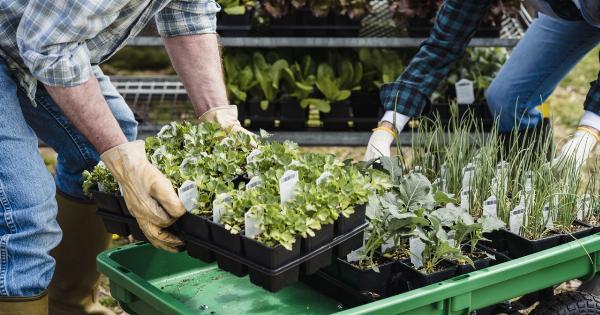Fruits and vegetables are important parts of a balanced diet, providing essential nutrients and vitamins that our body requires on a daily basis.
However, it is unfortunate that not all fruits and vegetables are grown and cultivated in the most natural way possible. Pesticides are chemicals used to control pest, weeds, and diseases that can damage crops and lead to a decrease in yield.
While these chemicals are deemed necessary for agriculture, the long-term and cumulative effects of pesticide use on human health and the environment are cause for concern.
In this article, we will highlight the top 30 fruits and vegetables that are most likely to contain pesticides.
1. Strawberries
While delicious, strawberries remain the most pesticide-laden fruit. More than 90% of strawberries sampled contain at least one pesticide and up to 20 types of pesticide residue have been found on a single strawberry.
2. Spinach
A whopping 97% of spinach tested contained pesticides, including insecticides, fungicides and herbicides. Some as many as 15 different pesticide residues are found on samples of spinach.
3. Kale
Kale is one of the most nutrient-dense vegetables, but it is often contaminated with pesticides. Pesticide residue has been found on kale, with 60% of samples testing positive for as many as 18 different pesticides.
4. Nectarines
Nectarines grow quickly and are often sprayed with pesticides as a result. Conventionally-grown nectarines are some of the most pesticide-contaminated fruits, with 94% of samples showing residue from at least two pesticides.
5. Apples
Apples are notoriously sprayed with pesticides as they are vulnerable to a variety of pests and diseases. More than 90% of apple samples contain detectable levels of pesticides that are often linked to cancer, ADHD, and birth defects.
6. Grapes
Conventionally-grown grapes, including grapes that used to make wine, are often sprayed with multiple pesticides.
Ninety-six percent of grape samples tested positive for at least one pesticide residue, while a single sample has shown 15 different types of pesticides.
7. Peaches
Like nectarines, peaches are quick-growing fruit and are sprayed with a range of different pesticides. Pesticide residue has been found on 99% of peach samples from grocery stores, farmers’ markets, and orchards.
8. Cherries
Cherries are highly susceptible to pests and diseases, which means they are often sprayed with pesticides. Tests have shown that cherries contain more than three times as many pesticide residues as fruits such as grapefruits and oranges.
9. Pears
The soft skin of pears makes them vulnerable to pests and diseases, making them a heavily sprayed crop. After apples, pears were the second most pesticide-laden fruit with up to 12 types of pesticide residues found on samples.
10. Tomatoes
Tomatoes are a heavily sprayed crop, especially when grown in large-scale settings. Samples have shown that more than 50% of tomatoes contain detectable levels of pesticide residue.
11. Bell Peppers
Bell peppers are a part of the nightshade family and are prone to pests and diseases. As a result, they are often sprayed with a range of pesticides.
More than 60% of samples tested positive for pesticides, while one sample revealed 15 different types of pesticides.
12. Potatoes
Potatoes are treated with a range of pesticides, including insecticides and fungicides, making them a heavily contaminated crop. In the US, potatoes have a higher toxicity rate than any other vegetable crop.
13. Hot Peppers
Hot peppers are often sprayed with a range of pesticides, which can result in high levels of pesticide residue in the final product. More than 75% of hot pepper samples contained residues from at least one pesticide.
14. Cucumbers
Cucumbers are prone to insect pests, which means they are often heavily treated with insecticides. Pesticide residue has been found on more than 60% of cucumber samples, including residues from as many as ten different pesticides.
15. Blueberries
Blueberries contain high levels of antioxidants and are often considered a superfood. However, more than 50% of blueberry samples contain detectable levels of pesticide residue.
16. Lettuce
Lettuce is a fast-growing crop and is highly susceptible to pests and diseases. As a result, it is sprayed with a range of pesticides that can lead to pesticide contamination. More than 50% of lettuce samples have detectable concentrations of pesticides.
17. Strawberries
Strawberries are a highly sprayed crop that is vulnerable to a range of pests and diseases. As such, pesticide contamination is common in strawberries, with up to 20 different types of pesticide residue found on a single strawberry.
18. Celery
Celery is another fast-growing crop that is highly sprayed with pesticides. Test results show that up to 20 different types of pesticide residue can be found on a single sample of celery.
19. Sweet Corn
Sweet corn is prized for its sweet flavor and is grown in large quantities as a result. The crop is sprayed with a variety of pesticides that can result in pesticide contamination. More than 88% of samples have detectable levels of pesticide residue.
20. Raspberries
Raspberries are a highly sprayed crop that is prone to pests and diseases. As a result, they are often sprayed with a variety of pesticides. More than 50% of samples tested positive for detectable levels of pesticide residue.
21. Snap Peas
Snap peas are fast-growing crops which are highly sprayed with pesticides. More than 60% of snap pea samples tested positive for various pesticide residues.
22. Beans
Beans are a source of protein and are used in many different dishes. However, conventionally-grown beans are often sprayed with pesticides that can result in pesticide contamination.
Tests have shown that more than 18 types of pesticide residue can be found on samples of beans.
23. Broccoli
Broccoli is a nutrient-dense vegetable that is often considered essential for a balanced diet. However, it is also prone to pests and diseases and is often sprayed with a range of pesticides.
More than 59% of broccoli samples contain detectable levels of pesticide residue.
24. Onions
Onions are widely used in cooking and are an important ingredient in many dishes. However, they are also a crop that is heavily sprayed with pesticides. More than 90% of onions samples tested positive for pesticide residues.
25. Peas (Frozen)
Frozen peas are popular with consumers, especially as they can be used to add a healthy twist to many meals. However, frozen peas are also a heavily treated crop that can be contaminated with pesticides.
More than 40 types of pesticide residue have been found on samples of frozen peas.
26. Pineapples
Pineapples are a tropical fruit that is not typically sprayed with pesticides. However, when grown conventionally, pesticides can be used to improve yields and to protect against pests and diseases.
As such, more than 50% of pineapple samples tested positive for at least one pesticide residue.
27. Sweet Potatoes
Sweet potatoes are a popular vegetable that may be consumed for their sweet flavor or health benefits. However, like other root vegetables, sweet potatoes are susceptible to pests and diseases, leading to the application of pesticides.
Over 75% of sweet potato samples tested positive for detectable levels of pesticide residue.
28. Oranges
Oranges are widely consumed fruits that are high in vitamin C. However, like many other citrus fruits, they are susceptible to pests and diseases, leading to the application of pesticides.
More than 60% of orange samples tested positive for pesticide residue.
29. Watermelons
Watermelons are a summer favorite, but they are usually grown in large-scale farms where pesticides are often used.
More than 70% of watermelon samples have detectable levels of pesticide residue, raising concerns regarding the health implications of excessive pesticide usage on this crop.
30. Carrots
Carrots are often heavily sprayed with pesticides to protect them from pests and diseases. Irrigation, the soil’s type, and weather conditions can also affect the quantity and type of pesticides applied in some regions.
Thus, more than 50% of carrots samples contain detectable levels of pesticide residue.
Conclusion
While fruits and vegetables are important components of a healthy diet, the overuse and misuse of pesticides in agriculture can lead to harmful consequences on human health and the environment.
It is essential to understand the potential risks of consuming pesticide-laden products, especially fruits and vegetables. Selecting organic or locally grown crops can help reduce the risk of exposure to pesticides and ensure the produce provides the essential vitamins and nutrients and minimize the harmful effects of pesticides.































